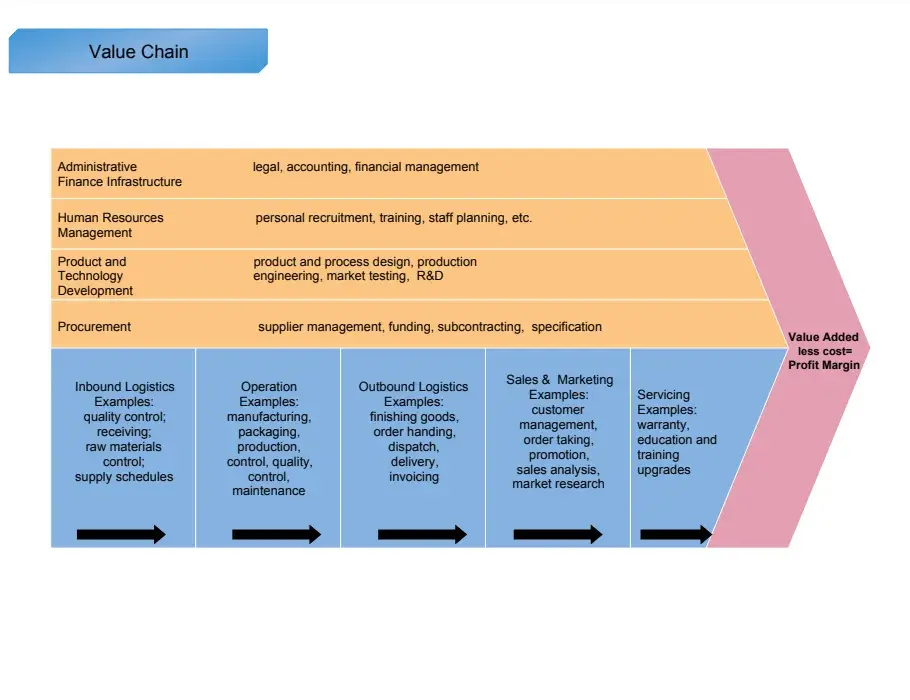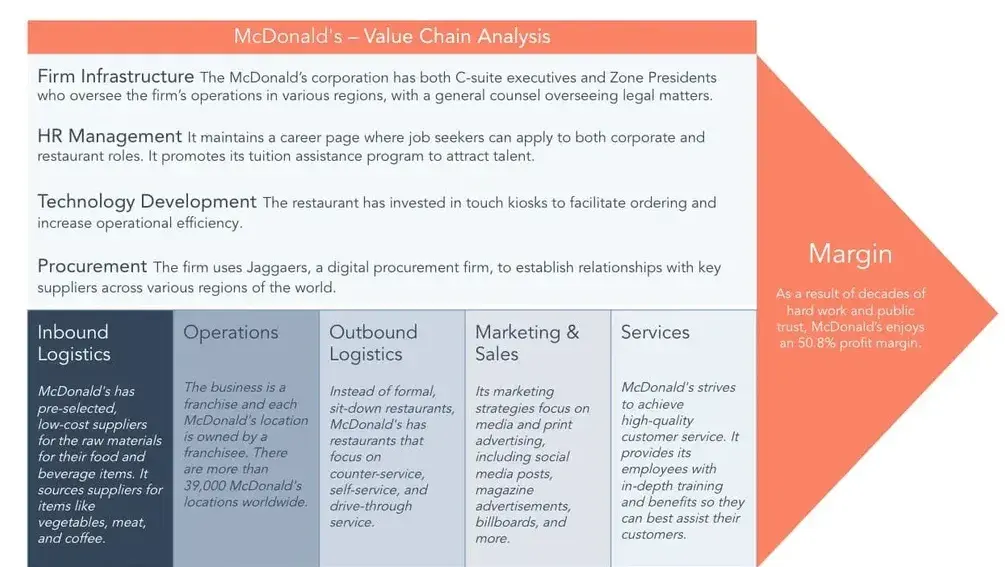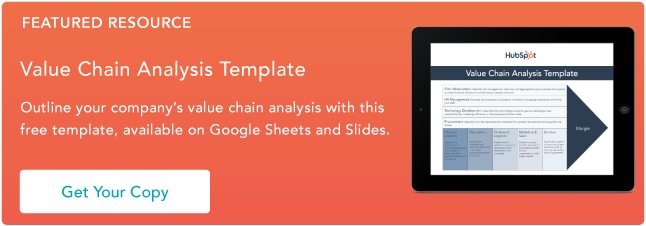Here’s what I’ll cover:
- What is a Value Chain?
- What is Value Chain Analysis?
- Components of a Value Chain
- How to Create a Value Chain Analysis
- Value Chain Analysis Example
- Value Chain Analysis Templates
Value chain analysis is a way for businesses to analyze the activities they perform to create a product. Once the activities are analyzed, a business can use the results to evaluate ways to improve its competitive advantage.
While one goal of value chain analysis is to improve operational efficiency, its final and most important goal is to establish an advantage over competitors.
Components of a Value Chain
If you’re like me and are curious about what *exactly* goes into a value chain, let’s turn to Michael Porter, a Harvard Business School professor. In his book Competitive Advantage, Porter introduces a simple value chain model. He lays out the components of a value chain analysis and places business activities into two categories: primary and support.
Identifying the primary and support activities is critical in creating a value chain analysis. You’ll know where you spend the most resources, where your business can improve, and where your competitors may have an edge over you.
Using Porter’s value chain model, you can look at your business activities, pinpoint a unique value proposition, and determine the best way to establish dominance over your competition.
Let’s take a look at these activities below.
Primary Activities
There are five primary activities. These activities are all of the actions involved in creating a business offering and competitive advantage. Here’s a breakdown of each one:
- Inbound logistics. This is how materials and resources are gained from suppliers before the final product or service can be developed. In your analysis, take a look at the locations of your suppliers and shipping costs from their facility to yours.
- Operations. Operations are how the materials and resources are produced, resulting in a final product or service. Here, you may look at the cost of running your warehouse, machinery, and assembly lines.
- Outbound logistics. Once a product is finished, it needs to be distributed. Outbound logistics describes this process. Consider your shipping costs to consumers, warehousing fees, distributor relations, and order processing operations.
- Marketing and sales. This is how your product or service is presented and sold to your ideal target market. In your analysis, take into account advertising costs, promotional costs, reach, and cost-per-acquisition.
- Services. This is the support a business provides for the customer, which can include product support and training, warranties, and guarantees. You’ll look at repair costs, product training costs, product adjustment frequency, and more.
Support Activities
Support activities help the primary activities maintain efficiency and create an advantage over competitors. They include:
- Firm infrastructure. This entails all the management, financial, and legal systems a business has in place to make business decisions and effectively manage resources.
- Human resource management. Human resource management encompasses all the processes and systems involved in managing employees and hiring new staff. This is especially important for companies that provide in-person service.
- Technology development. Technology development helps a business innovate. This can be used in various steps of the value chain to gain an advantage over competitors by increasing efficiency or decreasing production costs.
- Procurement. This is how the resources and materials for a product are sourced. The goal is to find quality supplies that fit the business' budget.
Value chain analyses require research and can take time to develop. Below are the general steps for creating one.
It’s now time to bring it all together in a unified process to create a value chain analysis. Let’s get started.
1. Determine the business' primary and support activities.
As I mentioned above, your business’s primary and support activities are the main components of the value chain. These activities include each action required in developing a product or service, from raw materials to the final product.
Pro tip: Not sure what to include or where each activity belongs? I find it helpful to use a template when I need guidance. HubSpot’s Value Chain Analysis Template is a great resource for this exercise.
2. Analyze the value and cost of the activities.
When I’m tasked with creating a value chain analysis, I know the first thing I want to do is brainstorm ways each activity provides value to customers and the business as a whole. Then, I compare the activity to the competitive advantage I'm trying to achieve and see if it supports the goal.
After the value analysis is complete, look at the cost of the activities. Is the activity labor-intensive? How much does X raw material cost?
Asking similar questions will help identify which activities are cost-effective and which are not. This is where areas for improvement can be identified.
Pro tip: Don’t be afraid to pull out the books for this step. You need to know exactly what the costs of goods and services are for all of the activities you’re analyzing. Refer to your balance sheet to make sure you’re not missing any costs.
3. Refer to your competitors' value chains.
A value chain analysis improves your competitive advantage, so any business that conducts one should keep that information close to the chest. In all likelihood, you won‘t happen upon a nuanced, in-depth picture of your competitors’ primary and support activities.
Still, you can get some concept of your industry peers' value chains through competitive benchmarking — using relevant metrics to compare your company to competitors’. The practice is multifaceted and is used for three primary functions:
- Strategic benchmarking. Comparing business models and strategies.
- Process benchmarking. Comparing business and operational processes.
- Performance benchmarking. Comparing business outcomes based on a set of metrics.
Once you‘ve identified the benchmarking category you’d like to pursue, you can pick the competitors you‘d like to measure yourself against. Then, you’d choose metrics that you can realistically collect data for and leverage resources that enable the relevant research.
Pro tip: I find it helpful to look at how other companies create a value chain analysis, even if they aren’t direct competitors. Here’s an example of a value chain analysis for Starbucks that I find useful.
4. Understand your customer base's perception of value.
You and I both know how the saying goes: the customer is always right. So, however valuable your customers perceive your product or service to be is exactly how valuable it actually is. Customer perception might be the most crucial factor in framing your competitive advantage, so you need to have a pulse on it.
Pro tip: Conducting customer surveys or gathering feedback from customers helps you understand your target market’s perception of you and is central to conducting a fully realized value chain analysis.
5. Identify opportunities to gain a competitive advantage.
Once the value chain analysis is complete, the primary stakeholders in the business can see an overview of where the business is excelling and where improvements can be made operationally.
Begin with the improvements that take minor changes and provide high-impact results. After the easy wins are identified, you and your team can tackle the bigger challenges that might be hindering efficiency.
The value chain analysis gives businesses a clear idea of how to adjust their actions and processes to provide the most value to their target market and increase their profit margins.
Still not sure how it all works? Let’s take a look at an example.
Value Chain Analysis Example
Completing a value chain analysis allows businesses to examine their activities and find competitive opportunities.
For example, McDonald‘s mission is to provide customers with low-priced food items. The analysis helps McDonald’s identify areas for improvement and activities that add value to their products and services.
Below is an example of a value chain analysis for McDonald's and its cost leadership strategy.
Primary Activities
- Inbound logistics. McDonald's has pre-selected, low-cost suppliers for the raw materials for their food and beverage items. It sources suppliers for items like vegetables, meat, and coffee.
- Operations. The business is a franchise, meaning a franchisee owns each McDonald's location. There are more than 41,000 McDonald's locations worldwide.
- Outbound logistics. Instead of formal, sit-down restaurants, McDonald's has restaurants that focus on counter-service, self-service, and drive-through service.
- Marketing and sales. Its marketing strategies focus on media and print advertising, including social media posts, magazine advertisements, billboards, and more.
- Services. McDonald's strives to achieve high-quality customer service. It provides its thousands of employees with in-depth training and benefits so they can best assist their customers.
Support Activities
- Firm infrastructure. The McDonald’s corporation has both C-suite executives and Zone Presidents who oversee the firm’s operations in various regions, with a general counsel overseeing legal matters.
- Human resource management. It maintains a career page where job seekers can apply to both corporate and restaurant roles. It pays hourly and salaried rates and promotes its tuition assistance program to attract talent.
- Technology development. The restaurant has invested in touch kiosks to facilitate ordering and increase operational efficiency.
- Procurement. The firm uses Jaggaer, a digital procurement firm, to establish relationships with key suppliers across various regions of the world.
Value Chain Analysis Templates
In my experience, templates have been helpful when I want to better understand a process or exercise. Here are a few value chain analysis templates to help you develop your own.
HubSpot's Value Chain Analysis Template
Available via Google Sheets and Google Slides, HubSpot’s free template is an interactive version of Porter‘s Value Chain Analysis. What I like best is the template can be customized to outline your company’s value chain. Get your free copy.
Porter's Value Chain Analysis Model

If you really want to understand a concept, you have to go straight to the source. This Porter's value chain analysis template is a free download that provides a general overview of business activities.
Template for Cost Profit Margin

If you‘re analyzing the cost versus expected profit margin from your primary and support activities, this template’s for you. I like that you can easily replace the data in the template with your own information while still maintaining the template structure.
Template for Educational Institutions

Value chain analysis isn’t a concept reserved for businesses that sell products or services. Educational institutions and non-profit organizations also benefit from this business strategy. What I like about this template is that this model looks at the value chain involved in developing academic research rather than analyzing the activities that go into creating a product or service.
Template for Products

Use this template to analyze the activities involved in creating a product from raw material to finished public product.
Template for Financial Acquisitions
.webp)
Did you recently acquire or merge with another business? Or maybe you plan to? If so, use this template to forecast and analyze the steps involved in the transition.
Grow Your Business with Value Chain Analysis
Your value chain analysis will help you identify areas for improvement and the activities that provide the most value to your customers and your business as a whole. Eliminating inefficient business activities speeds up production, improves your competitive advantage, and increases profit margins.
Editor's note: This post was originally published in November 2018 and has been updated for comprehensiveness.
.png?width=112&height=112&name=Image%20Hackathon%20%E2%80%93%20Horizontal%20(36).png)

.png)

-1.webp)
